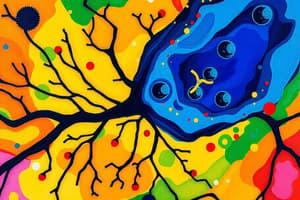Podcast
Questions and Answers
What is the primary function of mitochondria?
What is the primary function of mitochondria?
- Lipid storage
- Protein synthesis
- DNA replication
- Cell respiration (correct)
Which statement accurately describes the outer membrane of the mitochondria?
Which statement accurately describes the outer membrane of the mitochondria?
- It is smooth and permeable to small molecules. (correct)
- It contains many cristae.
- It is the site of ATP synthesis.
- It is highly folded to increase surface area.
What structural feature do the inner membranes of mitochondria possess?
What structural feature do the inner membranes of mitochondria possess?
- A smooth surface similar to the outer membrane
- Pores allowing large molecules to pass
- A rough surface with ribosomes
- Folds known as cristae (correct)
What is found within the intermembranous space of the mitochondria?
What is found within the intermembranous space of the mitochondria?
What is the relationship between the structure of mitochondria and their function?
What is the relationship between the structure of mitochondria and their function?
Where is the assembly site of ribosomal subunits typically located within a cell?
Where is the assembly site of ribosomal subunits typically located within a cell?
What is the primary function of the location where ribosomal subunits are assembled?
What is the primary function of the location where ribosomal subunits are assembled?
What does the shape of the nuclei in a cell help identify?
What does the shape of the nuclei in a cell help identify?
Which feature does NOT describe the typical shape of nuclei in cells?
Which feature does NOT describe the typical shape of nuclei in cells?
Which of the following activities does the cellular assembly location NOT perform?
Which of the following activities does the cellular assembly location NOT perform?
Flashcards are hidden until you start studying
Study Notes
Mitochondria Structure and Function
- Responsible for cellular respiration, converting nutrients into energy.
- Light Microscopy (LM) reveals cytoplasmic eosinophilia, indicating mitochondrial function.
Electron Microscopy (EM) of Mitochondria
- Mitochondria feature a double membrane structure:
- Outer membrane: smooth, permeable to small molecules via porin proteins.
- Inner membrane: folded into cristae, vital for biochemical processes.
Membrane Compartments
- Intermembranous space: lies between the outer and inner membranes.
- Matrix space: located within the inner membrane and contains critical components.
Genetic and Biochemical Role
- The inner membrane houses nearly all cellular DNA.
- Contains the machinery for DNA replication and RNA transcription.
- Ribosomal subunit assembly occurs on the inner membrane.
Location and Shape
- Mitochondria typically reside centrally within cells but can also be found peripherally or basally.
- Shape varies, commonly spherical, which can aid in cell or tissue identification.
Chromatin Types
- Heterochromatin: condensed, inactive chromatin representing low transcription rates.
- Euchromatin: extended, active chromatin ready for high transcription rates; transforms from heterochromatin when needed.
Functional Implications
- Active cells contain more euchromatin, reflecting a high transcription rate.
- Inactive cells predominantly feature heterochromatin, limiting transcription activity.
Studying That Suits You
Use AI to generate personalized quizzes and flashcards to suit your learning preferences.




